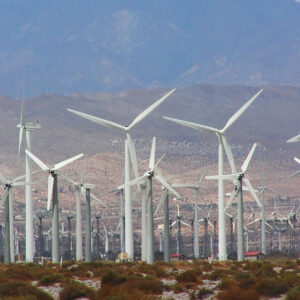Winter Storm Uri, with its plunging temperatures and bitter winds, left millions without power and at least 246 people dead in 2021. It also inspired two Austin-based filmmakers to produce a docuseries on the fragility of the nation’s electric grid and the failures of renewables.
“Juice: Power, Politics, and The Grid” is a five-part series produced by filmmakers Tyson Culver and Robert Bryce. They have vivid memories of the near-complete failure of the Texas electric grid during the storm, which left 69 percent of Texans without electricity over the course of a week in February. Nearly half the state experienced disruptions in water service, according to a survey from the University of Houston Hobby School of Public Affairs.
“If you don’t have food or water, that’s problematic,” Culver said. “If you don’t have electricity, you don’t have food or water. Bad things happen when the juice goes out.”
The series is comprised of five parts, each about 20 minutes long, examining the threats to the electric grid, including the green energy revolution and activists’ disdain for nuclear power. It is hosted on YouTube and its namesake website. The series also looks at the nearly complete meltdown of Texas’ electric grid. Ed Hirs, an Energy Fellow at the University of Houston, comments that the Electric Reliability Council of Texas (ERCOT) grid, which provides power to nearly 90 percent of the state, was four to five minutes from going down entirely.
Just four months prior, energy industry veteran and author Meredith Angwin, who was also interviewed for the docuseries, published a book titled, “Shorting the Grid: The Hidden Fragility of Our Electric Grid.” She said the Texas grid almost collapsed due to a “fatal trifecta” of an over-reliance on renewable energies, an over-reliance on natural gas, and depending on a neighboring grid to help in an emergency.
“The more I learned, the more I realized the grid was getting more and more fragile, more and more expensive, rolling blackouts in all kinds of areas were becoming more and possible, [and] more and more likely,” Angwin said.
Both Bryce and Culver said they aim to shift the conversations that policymakers, regulators, and consumers have about energy from a partisan issue to one that underscores the importance of energy security and diversification.
“We see the absolute need for policymakers and people to understand why the grid is so important,” Bryce said. “It’s the mother network. It’s the energy network upon which all other societal networks depend. We take it for granted at our extreme peril.”
Bryce’s great uncle was a member of the Osage Nation Indian tribe that sued Enel Group, an Italian company that built 84 wind turbines on tribal land in Oklahoma without the tribe’s permission. Interviews with tribal members for the docuseries indicate that even they thought their lawsuit was a long shot. But in December, a federal judge ruled in their favor, saying Enel violated their sovereignty to mine rocks since the tribe owned the mineral rights to the land. Enel will have to remove all 84 of the 420-foot turbines on Osage land. The company has received $10 million in federal tax credits annually since 2015 to manufacture and produce renewable energy.
“The Osage tribe kicked Enel’s butt in court,” said Bryce, who has been tracking land-use conflicts over wind and solar energy projects for more than a decade. “It’s a landmark ruling, and it’s an enormous black eye for the wind industry.”
The series makes the point that since 2015, communities across the country have rejected more than 400 wind projects and more than 150 solar projects. It also looks at the fallacies of the renewables industry, which promises “clean” energy without mentioning what’s needed to produce it.
One wind turbine requires 900 tons of steel, 2,500 tons of concrete, and 45 tons of plastic, episode three, “Green Dreams,” states. Wind and solar require 300 to 400 times as much land to produce the equivalent amount of electricity as one nuclear plant.
Both Bryce and Culver are unabashed supporters of nuclear energy, which they say is reliable, affordable, and — most importantly — safe. The series looks at the steps of Japan’s nuclear industry to reclaim the confidence of people after the crisis at the Fukushima plant following an earthquake and tsunami in 2011. It also examined Canada’s resurgence of nuclear power, which makes up 15 percent of the country’s energy sources from 19 reactors.
“If we’re serious about grid security and reducing CO2 emissions, we have to be serious about nuclear,” Bryce said. “I am encouraged by the increase in bipartisan support [in Washington, D.C.] for nuclear energy. It’s not enough; we need more, but we’re moving in the right direction.”
“Juice: Power, Politics, and The Grid” will be screened at the Circle Cinema Theater in Tulsa, Okla., on Feb. 15, in addition to other locations in the near future in Dallas and Austin, Texas, and Washington, D.C.


